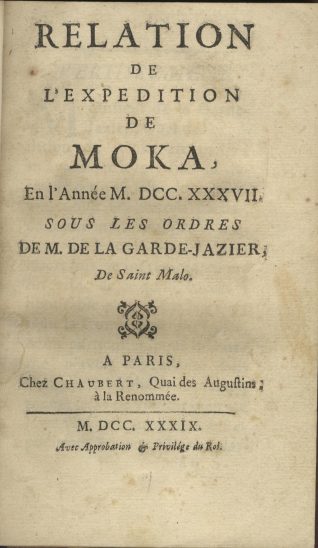Relation de l’expédition de Moka, en l’année M. DCC. XXXVII, sous les ordres de M. de la Garde-Jazier, de Saint-Malo.
Desfontaines, Abbé Pierre François Guyot (1685-1745).
Synopsis
Abbé Pierre-François Guyot Desfontaines (1685-1745) was a Jesuit and French literary figure. In 1724, he was one of the editors of the leading French journal known as the Journal des Savants, in collaboration with Fréron, Granet, Destrées, etc.
This is a major work covering the history of Mocha, the port city in Yemen, known for the quality of its Arabica coffee. The name Mocha became famous in Europe in the 16th and 17th centuries. The first café selling coffee opened in 1554 in Constantinople.
Harvested in Yemen, coffee was transported in small vessels to Jeddah where Turkish ships embarked for Suez and Egypt. The majority of the coffee destined for European countries was bought from Venetian merchants and the French (in Marseilles). However, the Dutch were also able to establish a factory in Mocha, and each year, a Dutch vessel had to dispatch coffee to Batavia from where it was sent back to Europe.
A unique edition of this interesting narration of the 1737 East India Company expedition to Mocha, written by the Abbé Desfontaines and taken from the Journal of Pierre-Alexandre de la Garde-Jazier, the Wing Commander of the expedition. Nephew of the famous René Duguay-Trouin, Pierre-Alexandre de la Garde-Jazier was chosen for his qualities as a soldier and negotiator, to set straight the governor of Mocha and the general treasurer of the Iman, who had shown dissent and corruption in his dealings in the coffee trade in Mocha, thus violating the Treaty signed with the East India Company. The fleet moored in Mocha in January 1737. They attacked the city, before entering into negotiations with the Imam, whose removal and dismissal was obtained by de la Garde-Jazier from the governor. A new and favourable agreement was then negotiated for the French and a trade deal reached with compensation for the harm done.
Bibliographic references: Gay, 3684; Boucher de La Richarderie, IV, p. 440.






